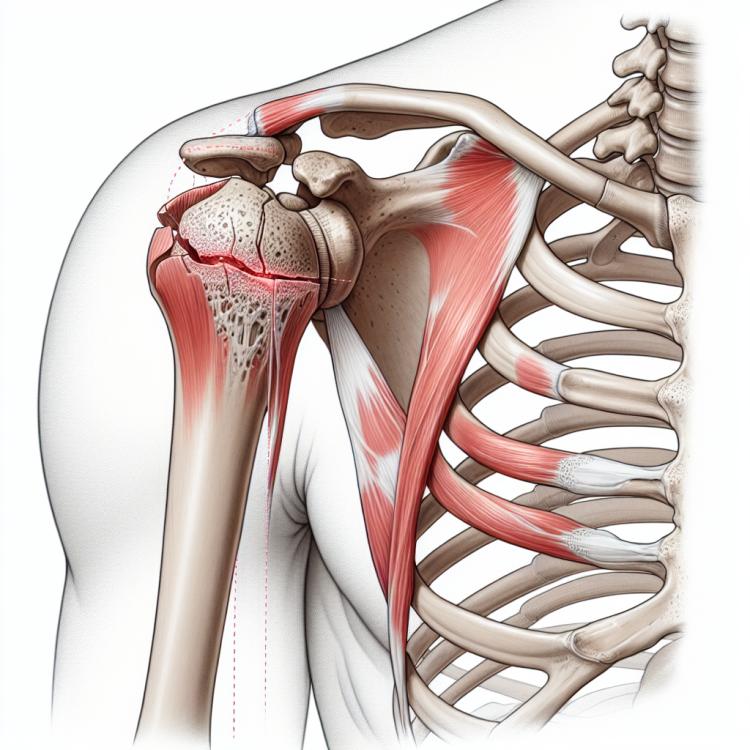
Fracture of the greater tubercle of the humerus: diagnosis, treatment, and rehabilitation
- Description of a fracture of the greater tubercle of the humerus: causes, symptoms, and treatment
- Factors contributing to the fracture of the greater tubercle of the humerus
- Manifestations of a fracture of the greater tubercle of the humerus
- Approaches to the treatment of greater tubercle fracture of the humerus from the experts’ perspective
- Methods for diagnosing a fracture of the greater tubercle of the humerus
- Methods of treating a fracture of the greater tubercle of the humerus
- Measures to prevent a fracture of the greater tubercle of the humerus
- Amazing facts about the fracture of the greater tubercle of the humerus
- FAQ
Description of a fracture of the greater tubercle of the humerus: causes, symptoms, and treatment
A fracture of the greater tubercle of the humerus is a bone structure injury in the shoulder girdle area, the cause of which is usually related to trauma or a strong impact. Symptoms of this fracture may include sudden pain in the shoulder area, swelling, bruising, and limited mobility in the shoulder joint. To diagnose a fracture of the greater tubercle of the humerus, X-rays or additional examinations may be required, and both conservative and surgical methods are used for treatment depending on the severity of the injury.
Factors contributing to the fracture of the greater tubercle of the humerus
Fracture of the greater tubercle of the humerus may occur as a result of high-energy trauma, such as a fall on an outstretched arm or a direct impact to the shoulder area. This type of injury typically results from car accidents, sports injuries, or falls from a height.
Additional factors contributing to the fracture of the greater tubercle of the humerus include osteoporosis, which makes the bone more fragile and predisposed to fracture even with minor trauma, as well as certain types of sports activities that require increased use of the shoulder girdle and arm, which can increase the risk of shoulder injuries.
- High-energy trauma: Falling on an outstretched hand or direct impact to the shoulder area, often associated with car accidents, sports injuries, or falls from heights.
- Osteoporosis: Decreased bone density can make the bone more brittle, increasing the risk of fractures, including a fracture of the greater tubercle of the humerus.
- Sports injuries: Certain types of sports activities that require increased use of the shoulder girdle and arm can raise the risk of shoulder fractures, including a fracture of the greater tubercle of the humerus.
- Falls in old age: In elderly individuals, whose bones become more fragile with age, a fracture of the greater tubercle of the humerus is more likely with falls and injuries.
- Metabolic disorders: Some metabolic diseases, such as osteoporosis, can affect the quality of bone tissue and increase the risk of fractures, including a fracture of the greater tubercle of the humerus.
Manifestations of a fracture of the greater tubercle of the humerus
Fracture of the greater tubercle of the humerus is usually accompanied by characteristic symptoms such as severe pain in the shoulder area, which increases with movement, especially when trying to raise the arm or rotate the shoulder. Patients may also experience swelling and bruising in the shoulder area, related to damage to tissues and vessels as a result of the injury.
Other typical manifestations of a fracture of the greater tubercle of the humerus may include a feeling of instability or creaking during shoulder movement, limited mobility in the shoulder joint, and sometimes the occurrence of cracking when moving. Given the characteristic symptoms, it is important to note any changes in the condition of the shoulder and consult a specialist for diagnosis and treatment.
- Severe pain: a fracture of the greater tubercle of the humerus is accompanied by intense pain in the shoulder area, which worsens with movement.
- Swelling and bruising: swelling and bruising occur in the shoulder area due to tissue and vessel damage as a result of the injury.
- Limited mobility: patients may experience difficulty in raising their arm or rotating the shoulder due to the fracture of the greater tubercle of the humerus.
- Crepitus and instability: sometimes there may be a creaking sound during shoulder movement, and the patient may feel instability in the joint due to the damage.
- Cracking: during shoulder movement, cracking may occur, which can be another sign of a fracture of the greater tubercle of the humerus.
Approaches to the treatment of greater tubercle fracture of the humerus from the experts’ perspective
The expert opinion regarding the approaches to treating a fracture of the greater tubercle of the humerus emphasizes the importance of an individualized approach for each patient. Some experts recommend conservative treatment, which includes wearing a rigid immobilizer and physiotherapy, especially when the fracture is stable and not accompanied by significant displacement of the bone fragments.
Other experts underline the necessity of surgical intervention in cases where the fracture presents symptoms of instability, displacement of fragments, or in cases of complications. Surgical treatment may involve the reduction of fragments and fixation using plates, screws, or other implants to restore stability to the shoulder and ensure proper healing of the bone fragments.

Methods for diagnosing a fracture of the greater tubercle of the humerus
To diagnose a fracture of the greater tubercle of the humerus, various examination methods are usually used, including shoulder X-rays. X-rays allow for the precise determination of the presence of a fracture, the assessment of its characteristics, and the evaluation of the degree of displacement of the bone fragments. Additionally, in some cases, a computed tomography (CT) scan may be required for further image detail and treatment planning.
The criteria for diagnosing a fracture are described by physicians, taking into account clinical symptoms, examination data, and the overall condition of the patient. Timely diagnosis allows for the prompt initiation of treatment and contributes to the effective restoration of shoulder function after injury.
- X-ray: The primary diagnostic method that helps identify the presence of a fracture and assess its characteristics.
- Computed Tomography (CT): In cases where additional imaging detail is required, a CT scan is performed for a more accurate determination of injuries.
- Clinical examination: The doctor conducts a physical examination and identifies clinical symptoms that may indicate the presence of a fracture.
- Magnetic Resonance Imaging (MRI): Appointed in cases where a more detailed study of the tissues and structures in the shoulder area is required.
- Ultrasound examination: This method can complement the examination, especially when it is necessary to assess soft tissues and vessels.
Methods of treating a fracture of the greater tubercle of the humerus
In cases of displaced or complex fractures, surgical intervention may be required, which may involve osteosynthesis (the introduction of special fixation elements) or other reconstruction methods. The decision on the treatment method is made based on the individual characteristics of the patient, the nature of the injury, and the prognosis for recovery of shoulder joint function.
- Conservative treatment: includes the immobilization of the shoulder using a special bandage or plaster cast to ensure the shoulder joint rest and maintain the bone in the correct position.
- Physiotherapy: is conducted to restore mobility and strength in the shoulder joint after the immobilization of the shoulder ends.
- Surgical treatment: may be necessary for displaced or complicated fractures, including osteosynthesis or other methods of bone reconstruction.
- Rehabilitation: is an important component of treatment, including special exercises and procedures to restore shoulder function and prevent complications after the fracture.
- Individual approach: the choice of treatment method is based on the individual characteristics of the patient, the nature of the injury, and the prognosis for the recovery of shoulder joint function.
Measures to prevent a fracture of the greater tubercle of the humerus
Other preventive methods include maintaining a diet rich in calcium and vitamin D to strengthen bones and prevent osteoporosis, which can increase vulnerability to fractures. Regular check-ups with a doctor can help identify early signs of bone tissue weakening and take timely measures to strengthen the skeleton, which also contributes to fracture prevention.
- Strengthening muscles and ligaments: Regular exercises aimed at strengthening the muscles and ligaments of the shoulder girdle can reduce the risk of injuries and fractures.
- Adherence to safety rules: When engaging in sports or physical activities, it is important to follow safety rules to avoid traumatic situations.
- Diet rich in calcium and vitamin D: Proper nutrition, enriched with calcium and vitamin D, contributes to strengthening bones and preventing osteoporosis.
- Regular check-ups with a doctor: Doctor’s check-ups can help detect early signs of bone tissue weakening and take timely measures to strengthen the skeleton.
- Avoiding risky situations: Avoiding risky actions that could lead to shoulder girdle injuries will help prevent fractures.
Amazing facts about the fracture of the greater tubercle of the humerus
Interestingly, in some patients, the so-called “pseudofracture” of the greater tubercle may be observed, which does not always appear on the X-ray immediately after the injury. This point highlights the importance of consulting a specialist and undergoing a detailed examination in cases of suspected fracture in this area of the shoulder.